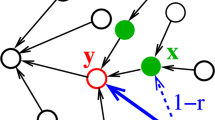Abstract
The problem of making a given directed graph strongly connected was well-investigated by Eswaran and Tarjan (SIAM J Comput 5:653–665, 1976). In contrast, the problem of making a given bidirected graph strongly connected has not yet been formulated. In this paper, we consider two related problems: making a given bidirected graph strongly connected with either the minimum cardinality of additional signs or the minimum cardinality of additional arcs. For the former problem, we show a closed formula of the minimum number of additional signs and give a linear-time algorithm for finding an optimal solution. For the latter problem, we give a linear-time algorithm for finding a feasible solution whose size is either equal to or more than the obvious lower bound by one.







Similar content being viewed by others
References
Ando, K., Fujishige, S.: \(\sqcup \),\(\sqcap \)-closed families and signed posets. Discussion Paper Series 567, Institute of Socio-Economic Planning, University of Tsukuba (1994)
Ando, K., Fujishige, S.: On structures of bisubmodular polyhedra. Math. Progr. 74, 293–317 (1996)
Ando, K., Fujishige, S., Nemoto, T.: Decomposition of a bidirected graph into strongly connected components and its signed poset structure. Discrete Appl. Math. 68, 237–248 (1996)
Arkin, E.M., Hassin, R., Shahar, S.: Increasing digraph arc-connectivity by arc addition, reversal and complement. Discrete Appl. Math. 122, 13–22 (2002)
Babenko, M.A.: Acyclic bidirected and skew-symmetric graphs: algorithms and structure. In: International Computer Science Symposium in Russia, pp. 23–34. (2006)
Bérczi, K., Iwata, S., Kato, J., Yamaguchi, Y.: Making bipartite graphs DM-irreducible. SIAM J. Discrete Math. 32, 560–590 (2018)
Edmonds, J., Johnson, E. L.: Matching: a well-solved class of linear programs. In: Guy, R., Hanani, H., Sauer, N., Schönheim, J. (Eds.): Combinatorial Structures and Their Applications, pp. 88–92. (1970)
Eswaran, K.P., Tarjan, R.E.: Augmentation problems. SIAM J. Comput. 5, 653–665 (1976)
Frank, A.: Augmenting graphs to meet edge-connectivity requirements. SIAM J. Discrete Math. 5, 25–53 (1992)
Goldberg, A.V., Karzanov, A.V.: Maximum skew-symmetric flows. In: Proceedings of the Third Annual European Symposium on Algorithms, pp. 155–170. (1995)
Goldberg, A.V., Karzanov, A.V.: Path problems in skew-symmetric graphs. Combinatorica 16, 353–382 (1996)
Goldberg, A.V., Karzanov, A.V.: Maximum skew-symmetric flows and matchings. Math. Program. 100, 537–568 (2004)
Harary, F.: On the notion of balance of a signed graph. Michigan Math. J. 2, 143–146 (1955)
Iwata, S.: Block triangularization of skew-symmetric matrices. Linear Algebra Appl. 273, 215–226 (1998)
Karp, R. M.: Reducibility among combinatorial problems. In: Miller, R. E., Thatcher, J. W. (Eds.): Complexity of Computer Computations, pp. 85–103. (1972)
Medvedev, P., Brudno, M.: Maximum likelihood genome assembly. J. Comput. Biol. 16, 1101–1116 (2009)
Medvedev, P., Georgiou, K., Myers, G., Brudno, M.: Computability of models for sequence assembly. Algorithms in Bioinformatics, pp. 289–301. (2007)
Tutte, W.T.: Antisymmetrical digraphs. Can. J. Math. 19, 1101–1117 (1967)
Watanabe, T., Nakamura, A.: Edge-connectivity augmentation problems. J. Comput. Syst. Sci. 35, 96–144 (1987)
Yasuda, T.: Inferring chromosome structures with bidirected graphs constructed from genomic structural variations. Ph.D. Thesis, The University of Tokyo (2015)
Zaslavsky, T.: Orientation of signed graphs. Eur. J. Comb. 12, 361–375 (1991)
Acknowledgements
Both authors are supported by JSPS Research Fellowship for Young Scientists. The research of the first author was supported by JSPS KAKENHI Grant Number JP16J06879. Authors would like to thank the anonymous reviewer for the valuable comments.
Author information
Authors and Affiliations
Corresponding author
Additional information
Publisher's Note
Springer Nature remains neutral with regard to jurisdictional claims in published maps and institutional affiliations.
Rights and permissions
About this article
Cite this article
Matsuoka, T., Sato, S. Making Bidirected Graphs Strongly Connected. Algorithmica 82, 787–807 (2020). https://doi.org/10.1007/s00453-019-00613-5
Received:
Accepted:
Published:
Issue Date:
DOI: https://doi.org/10.1007/s00453-019-00613-5




